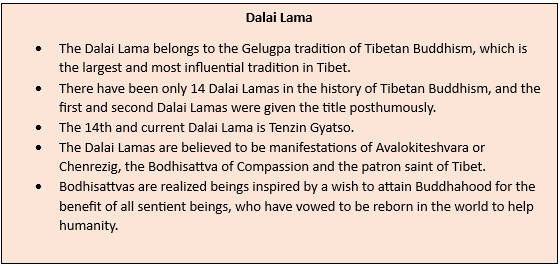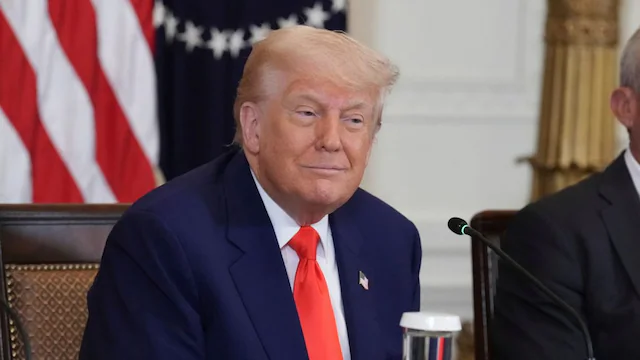- Courses
- GS Full Course 1 Year
- GS Full Course 2 Year
- GS Full Course 3 Year
- GS Full Course Till Selection
- Online Program
- GS Recorded Course
- NCERT (Recorded 500+ Hours)
- Polity Recorded Course
- Geography Recorded Course
- Economy Recorded Course
- AMAC Recorded Course
- Modern India, Post Independence & World History
- Environment Recoded Course
- Governance Recoded Course
- Science & Tech. Recoded Course
- International Relations and Internal Security Recorded Course
- Disaster Management Module Course
- Ethics Recoded Course
- Essay Recoded Course
- Current Affairs Recoded Course
- CSAT
- 5 LAYERED ARJUNA Mentorship
- Public Administration Optional
- ABOUT US
- OUR TOPPERS
- TEST SERIES
- FREE STUDY MATERIAL
- VIDEOS
- CONTACT US
CHINA-TIBET ISSUE
CHINA-TIBET ISSUE
10-10-2023

Context
Recently, the Dalai Lama reaffirmed his stance that Tibetans seek greater autonomy within China.
Tibet's Independence:
- Tibet is a region in Asia that is part of the Tibetan Plateau. It covers an area of over 2.4 million km2 or roughly 25% of China.
- It is the ancestral home of several other ethnic groups as well as the Tibetan people.
- At 4,900 metres above sea level, Tibet is the highest place on Earth. With an elevation of 8,848 metres above sea level, Mount Everest is the tallest peak in Tibet.
- Early in 1913, the 13th Dalai Lama, Thubten Gyatso, declared Tibetan independence de facto
What is the China-Tibet Issue?
- Chinese Invasion and Seventeen Point Agreement:
- China maintained its claims of authority over the area and refused to acknowledge Tibet's independence.
- Tibet Autonomous Region (TAR) was ruled by no Chinese government between 1912 and 1949 when the People's Republic of China was established.
- Up until 1951, only the Dalai Lama's administration governed the region. Before Mao Zedong's People's Liberation Army (PLA) marched into Tibet and invaded it, Tibet was not considered "Chinese."
- Tibetan authorities were compelled to sign a treaty that China had dictated in 1951. The "Seventeen Point Agreement," a deal that guarantees Tibetan autonomy and respects Buddhism, also permits the construction of Chinese military and governmental headquarters in Lhasa, the capital of Tibet.
- The Dalai Lama and the Tibetan people, however, believe it to be false.
- The Tibetan people and outside observers have frequently referred to this as "a cultural genocide."
- 1959 Tibetan Uprising:
- escalating tensions between China and Tibet resulted in a pivotal moment in 1959 when the Dalai Lama and a number of his adherents fled to India in search of safety.
- The Central Tibetan Administration (CTA), an exiled administration with its headquarters in Dharamshala, India, was established by Tibetans who adhered to the Dalai Lama.
- The aftermath of the 1959 Tibetan Uprising:
- The Chinese central government has been progressively enforcing greater control over Tibet since the Uprising of 1959.
- There is still arbitrary detention and no freedom of expression, religion, or the press in Tibet today.
- The survival of Tibetan culture is threatened by forced abortion, sterilisation of Tibetan women, and the transfer of low-income Chinese citizens.
- The demographic shift in the region is the result of China's encouragement of thousands of ethnic Han Chinese to migrate to Tibet, despite its investments in infrastructure improvements for the area, especially in Lhasa.
Impact of Tibet and the Dalai Lama on India-China Relations
- Since the Tibetan Autonomous Region shares the 3500 km Line of Actual Control (LAC) with India and not the rest of China, Tibet was considered India's real neighbour for centuries.
- Representatives from Tibet and China signed the Shimla accord with British India in 1914, which established boundaries.
- But China rejected the treaty and the McMahon line that separated the two nations when Tibet was fully admitted to China in 1950.
- Furthermore, as part of a 1954 deal, China and India agreed that Tibet would be recognised as the "Tibet region of China."
- Since China views the Dalai Lama as a separatist, his presence in India has long been a source of friction in relations between the two countries.
- The geopolitical implications and the importance of the Tibetan plateau for water resources complicate the relationship between China, India, and Tibet.
Recent Developments in Tibet
- In Tibet, China has been constructing and enhancing next-generation infrastructure, including internet connectivity projects, dams, border defence communities, and an all-weather oil pipeline.
- China is attempting to exert influence over the choice of the next Dalai Lama by highlighting the long-standing cultural ties between Tibet and China.
- Tibetans born in India after 1987 are not granted Indian citizenship by the government.
- The younger members of the Tibetan community now feel unsatisfied as a result.
India's stand on Tibet policy
- The Government of India, soon after India's independence in 1947, treated Tibet as a de facto independent country. However, more recently India's policy on Tibet has been mindful of Chinese sensibilities and has recognized Tibet as a part of China.
Global's stand on Tibet policy
- The US stands as a vocal supporter, with bipartisan backing and specialized coordinators for Tibet.
While global recognition is limited, Tibetans value India’s consistent support.

Q1. With reference to Indian history, who among the following is a future Buddha, yet to come to save the world? (UPSC-2018)
(a) Avalokiteshvara
(b) Lokesvara
(c) Maitreya
(d) Padmapani
Ans: (c)



